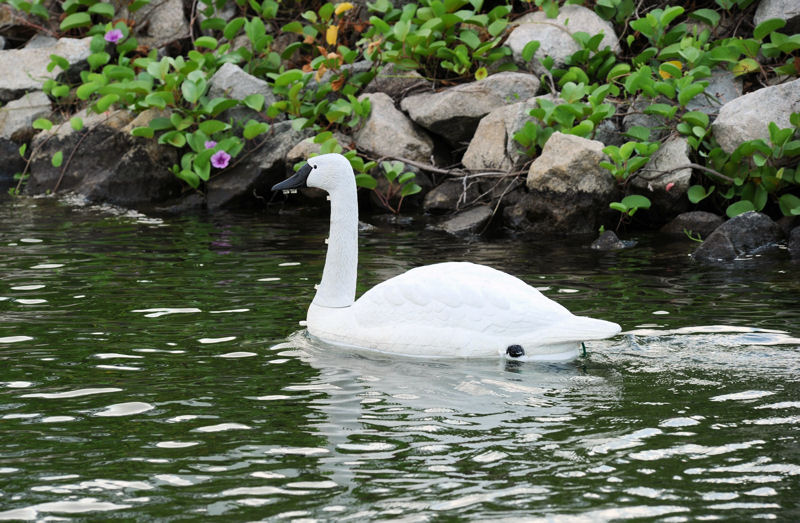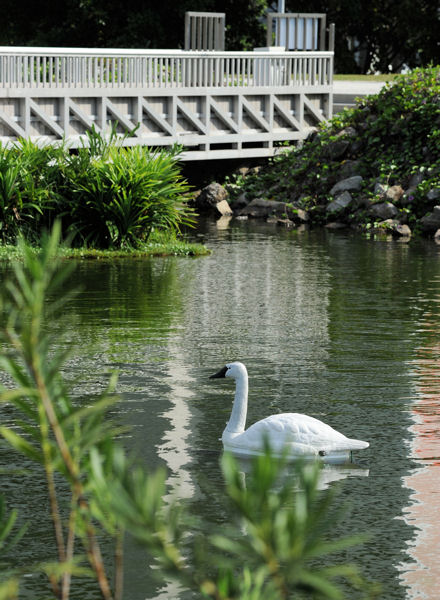
Scientists at the National University of Singapore’s Environmental Research Institute (NERI) are conducting water quality research on the Pandan Reservoir using New Smart Water Assessment Network (NUSwan) technology. Photo courtesy of the National University of Singapore.
A variant on the old saying, “If it looks like a duck, swims like a duck, and quacks like a duck — then it must be a duck,” may not hold true on the Pandan Reservoir in Singapore. In this reservoir, “If it looks like a swan and swims like a swan — then it may be a robot.”
Scientists at the National University of Singapore’s Environmental Research Institute (NERI) are conducting research on the reservoir using New Smart Water Assessment Network (NUSwan) technology hidden in autonomously operated, robotic swans that are used to collect real-time water quality data.
“NUSwan could potentially be used to monitor the levels of different physical and biological compounds, for example pH, dissolved oxygen, turbidity, and chlorophyll at a much improved resolution,” said Mandar Chitre, assistant professor at the Tropical Marine Science Institute (TMSI) in Singapore and the lead researcher.
Prior to the introduction of the three robotic swans to the reservoir, teams were collecting water quality data manually. Now, researchers gather data that has been relayed to the cloud using Wi-Fi. The technology enables researchers or operators to tailor their sampling strategy based on site conditions. And the NUSwan platform is “designed to be expandable — new sensors and actuators can be added on demand to increase its sensing capability,” Chitre said.
Swans were the answer

Before the introduction of the three robotic swans to the Pandan Reservoir, research teams were collecting water quality data manually. Now data is uploaded to the cloud using Wi-Fi and the NUSwans can be operated manually or automatically. Photo courtesy of NUS Environmental Research Institute.
Professor Ong Choon Nam, NERI director, approached Chitre and his research team 4 years ago with the “idea of using our STARFISH autonomous underwater vehicles [AUVs] for monitoring fresh waterbodies, such as rivers, lakes, and reservoirs,” Chitre said. Prior to this, there were no low-cost, environmentally friendly systems to routinely monitor a wide range of water quality parameters, he said.
“Although STARFISH AUVs could be used for the monitoring, I felt that they were over-engineered for this task and would not provide a cost-effective solution,” Chitre said. “A robot swimming at the surface would be a better solution and offer higher accuracy. Additionally, a robot that blended with the environment, in line with [Singapore’s Public Utilities Board’s] Active, Beautiful, Clean Waters Initiative, would be nice.”
From there, the NUSwan project was born, Chitre said. Engineers and chemists from TMSI and NERI worked to develop a prototype and NERI and the Public Utilities Board provided funding.
Enhancements planned
While the NUSwan operates on the surface of the water, the sensor can monitor any depth of water as long as it is fully submerged. The current version of the NUSwan starts measuring water quality at a depth of 0.25 to 1.5 m from the surface, Chitre said.
There is no limit to the monitoring area as long as the system is within cellular coverage. “However, it needs to operate in a large-enough-area to safely navigate within [Global Positioning System] accuracies,” Chitre said.

Robotic swans collect real-time data and monitor levels of different elements of water quality such as acidity, dissolved oxygen, turbidity, and chlorophyll. Photo courtesy of the National University of Singapore.
The project currently is in “its test-bedding stage, where several NUSwans run missions regularly at the test sites in Singapore, and the data collected during test bedding is validated against the data from other traditional monitoring methods,” Chitre said.
NERI researchers also are developing sensors and probes that could be incorporated into the NUSwan. The hope is to eventually integrate phosphate-sensing capability into the NUSwan, Chitre said.
“Several water authorities in Asia have also expressed interest in the NUSwan,” Chitre said. “China National Engineering Center as well as Shanghai Jiaotong University have expressed strong interest in using NUSwan for water surveillance in one of the world’s largest reservoirs in China,” he said.
— LaShell Stratton−Childers, WEF Highlights








September 29, 2015
Featured